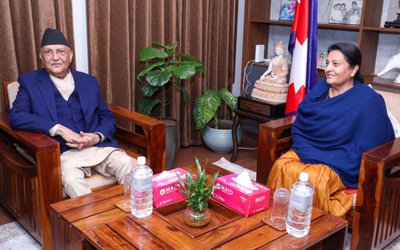
When Prime Minister Sushil Koirala, CPN-UML leader K.P. Sharma Oli and UCPN-Maoist leader Pushpa Kamal Dahal Prachanda rode a helicopter to go to Dhunche of Rasuwa District, there was a rush of press photographers to catch the moment.
As the rescue operation was at the final stage, three leaders were on a trip to monitor relief operations in Rasuwa, Dhading and Gorkha districts.
Although this is not the first occasion that the leaders of three parties were together, they have held several joint meetings following the great earthquake of April 25. They even drafted a common parliamentary resolution promising to go together to quake victims.
Following the earthquake, Nepali Congress and CPN-UML hastily agreed on the proposal forwarded by UCPN-Maoist to withdraw the foreign missions from the rescue and relief operations. Similarly, UCPN-Maoist was the first party to back formation of Prime Minister Relief Fund to centralize the distribution of relief through this. UCPN-Maoist has already deposited 3 million rupees in the fund to show its solidarity.
Despite unity in the agenda of launching effective rescue, relief and reconstruction of destroyed infrastructure, leaders of three political parties hold different views on the constitutional agenda.
As the recent rescue and relief operation suffers badly due to lack of elected representatives at the local bodies, the joint observation of leaders of three parties is likely to encourage the caders of three parties to demand their share in the relief distribution.
Due to political intervention by party workers, there is a growing concern over the distribution of relief materials to the needy people. Nepali Congress leaders have criticized the unequal distribution of relief materials to the needy people.
With the involvement of two district offices in the relief distribution, District Development Committee and District Administration Office, which are led by two major parties Nepali Congress and CPN-UML, the pressure is growing from the center on both the civil servants to take concern of the particular political parties.
Although leaders of political parties have declared that they will not put any pressure on the local officials and asked their workers to follow the rule, people have a little hope that they will take their leaders seriously.
However, leaders of three political parties are making efforts to show that they are united. “This is the time of national crisis. We can discuss our differences later. There is the need now to go together for nation building,” said CPN-UML leader K.P. Sharma Oli. “Our presence will give a good message.”
In the last two days, Prime Minister Koirala visited earthquake devastated districts alone and observed the relief operations. Nobodyknows who inspired the leaders of three parties to go jointly to the quake affected areas.
Prime Minister Koirala did not even consult the former prime minister and UCPN-Maoist leader Dr. Baburam Bhattarai while inspecting his constituency.PrimeMinister Koirala did not carry the minister representing CPN-UML either.
With the death of almost 8,000 and lost property worth of billions of rupees, the 7.6 Richter scale earthquake of April 25 affected almost eight million population of Nepal living in 23 districts.
“We are united for the cause of people who have been suffering from the great earthquake. We have our own stand on fundamentals of constitution but we don’t have any differences over providing relief to the people who suffered from the earthquake,” said Pushpa Kamal Dahal Prachanda. “This is a time for national unity.”
However, leaders of other political parties including Madhesi, Janjati and RPP-Nepal feel sidelined by the three big parties. In the entire phase of rescue and relief, RPP –Nepal distributed the relief materials, going it alone. However, no one saw any contribution of Madheshis and Janjati party.
At a time when there is no consensus on constitution and holding the local elections, the visit of three partiesto the affected districts is taken as both good and bad for reconstruction phase.
Common people suspect that the unity of three parties may give birth to unaccountable three party mechanisms in the distribution of relief operation and reconstruction of the infrastructure.
The current Earthquake Relief unity has nothing to do with the question of political stability and writing a new constitution and help accelerate the development pace. However, it will increase the life of lackluster government led by Nepali Congress.
- ECONOMY: Nepal To Grow 4.5 Percent
- May 21, 2025
- NC-UML COALITION: Facing Turbulence
- May 20, 2025
- PRO-MONARCHIST AGITATION: United Front
- May 19, 2025
- KOSHIYARI’S VISIT: Seeking Nepal’s Support
- May 19, 2025
- INDIA PAKISTAN CONFLICT: Nepal’s Security Challenges
- May 14, 2025















